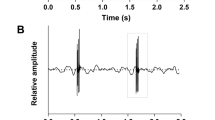Abstract
Non-human primates possess species-specific repertoires of acoustically distinct call types that can be found in adults in predictable ways. Evidence for vocal flexibility is generally rare and typically restricted to acoustic variants within the main call types or sequential production of multiple calls. So far, evidence for context-specific call sequences has been mainly in relation to external disturbances, particularly predation. In this study, we investigated extensively the vocal behaviour of free-ranging and individually identified Diana monkeys in non-predatory contexts. We found that adult females produced four vocal structures alone (‘H’, ‘L’, ‘R’ and ‘A’ calls, the latter consisting of two subtypes) or combined in non-random ways (‘HA’, ‘LA’ and ‘RA’ call combinations) in relation to ongoing behaviour or external events. Specifically, the concatenation of an introductory call with the most frequently emitted and contextually neutral ‘A’ call seems to function as a contextual refiner of this potential individual identifier. Our results demonstrate that some non-human primates are able to increase the effective size of their small vocal repertoire not only by varying the acoustic structure of basic call types but also by combining them into more complex structures. We have demonstrated this phenomenon for a category of vocalisations with a purely social function and discuss the implications of these findings for evolutionary theories of primate vocal communication.


Similar content being viewed by others
References
Altmann J (1974) Observational study of behavior: sampling methods. Behaviour 49:227–267
Arnold K, Zuberbühler K (2006) The alarm-calling system of adult male putty-nosed monkeys, Cercopithecus nictitans martini. Anim Behav 72:643–653
Arnold K, Zuberbühler K (2008) Meaningful call combinations in a non-human primate. Curr Biol 18:R202–R203
Bickerton D, Szathmáry E (2009) Biological foundations and origin of syntax. MIT Press, Cambridge
Bouchet H, Pellier A, Blois-Heulin C, Lemasson A (2010) Sex differences in the vocal repertoire of adult red-capped mangabeys (Cercocebus torquatus): a multi-level acoustic analysis. Am J Primatol 72:360–375
Catchpole CK, Slater PJ (1995) Bird song. Biological themes and variations. Press Syndicate University of Cambridge, Cambridge
Chomsky N (1981) Knowledge of language: its elements and origins. Philos Trans R Society of Lond B Biol Sci 295:223–234
Clarke E, Reichard UH, Zuberbühler K (2006) The syntax and meaning of wild gibbon songs. PLoS One 1:e73
Clay Z, Zuberbühler K (2009) Food-associated calling sequences in bonobos. Anim Behav 77:1387–1396
Clay Z, Zuberbühler K (2011) Bonobos extract meaning from call sequences. PloS One 6:e18786
Cleveland J, Snowdon CT (1982) The complex vocal repertoire of the adult cotton-top tamarin (Saguinus oedipus oedipus). Zeitschrift für Tierpsychologie 58:231–270
Corballis MC (2003) From hand to mouth: the origins of language. Princeton University Press, Princeton
Crockford C, Boesch C (2005) Call combinations in wild chimpanzees. Behaviour 142:397–421
Dunbar R (1998) Theory of mind and evolution of language. In: Hurford JR, Studdert-Kennedy M, Knight C (eds) Approaches to the evolution of language. Cambridge University Press, Cambridge, pp 92–110
Elowson AM, Snowdon CT (1994) Pygmy marmosets, Cebuella pygmaea, modify vocal structure in response to changed social environment. Anim Behav 47:1267–1277
Enard W, Przeworski M, Fisher SE, Lai CSL, Wiebe V, Kitano T, Monaco AP, Pääbo S (2002) Molecular evolution of FOXP2, a gene involved in speech and language. Nature 418:869–872
Ey E, Rahn C, Hammerschmidt K, Fischer J (2009) Wild female olive baboons adapt their grunt vocalizations to environmental conditions. Ethology 115:493–503
Gautier JP (1988) Interspecific affinities among guenons as deduced from vocalizations. In: Gautier-Hion A, Bourlière F, Gautier JP, Kingdon J (eds) A primate radiation: evolutionary biology of the African guenons. Cambridge University Press, Cambridge, pp 194–226
Gautier JP, Gautier A (1977) Communication in old world monkeys. In: Sebeok TE (ed) How animals communicate. Indiana University Press, Bloomington, pp 890–964
Gautier-Hion A (1988) Polyspecific associations among forest guenons: ecological, behavioural and evolutionary aspects. In: Gautier-Hion A, Bourlière F, Gautier JP, Kingdon J (eds) A primate radiation: evolutionary biology of the African guenons. Cambridge University Press, Cambridge, pp 452–476
Gerhardt HC, Roberts JD, Bee MA, Schwartz JJ (2000) Call matching in the quacking frog (Crinia georgiana). Behav Ecol Sociobiol 48:243–251
Green S (1975) Dialects in Japanese monkeys: vocal learning and cultural transmission of locale-specific vocal behavior? Zeitschrift für Tierpsychologie 38:304–314
Harcourt AH, Stewart KJ (1996) Function and meaning of wild gorilla ‘close’ calls 2. Correlations with rank and relatedness. Behaviour 133:827–845
Hauser MD (2000) A primate dictionary? Decoding the function and meaning of another species’ vocalizations. Cognit Sci 24:445–475
Hauser MD, Chomsky N, Fitch W (2002) The faculty of language: what is it, who has it, and how did it evolve? Science 298:1569–1579
Hill CM (1994) The role of female diana monkeys, Cercopithecus diana, in territorial defence. Anim Behav 47:425–431
Koda H, Shimooka Y, Sugiura H (2008) Effects of caller activity and habitat visibility on contact call rate of wild Japanese macaques (Macaca fuscata). Am J Primatol 70:1055–1063
Kroodsma DE (1982) Song repertoires: problems in their definition and use. In: Kroodsma DE, Miller HE (eds) Acoustic communication in birds. New York Academic Press, New York, pp 125–141
Lemasson A (2011) What can forest guenons “tell” us about the origin of language? In: Vilain A, Schwartz JL, Abry C, Vauclair J (eds) Primate communication and human language vocalisation, gestures, imitation and deixis in humans and non-humans. John Benjamins Publishing Company, Amsterdam, pp 39–70
Lemasson A, Hausberger M (2004) Patterns of vocal sharing and social dynamics in a captive group of Campbell’s monkeys (Cercopithecus campbelli campbelli). J Comp Psychol 118:347–359
Lemasson A, Hausberger M (2011) Acoustic variability and social significance of calls in female Campbell’s monkeys (Cercopithecus campbelli campbelli). J Acoust Soc Am 129:3341–3352
Lemasson A, Richard JP, Hausberger M (2004) A new methodological approach to context analysis of call production. Bioacoustics 14:111–125
Lemasson A, Hausberger M, Zuberbühler K (2005) Socially meaningful vocal plasticity in adult Campbell’s monkeys (Cercopithecus campbelli). J Comp Psychol 119:220–229
Lemasson A, Gandon E, Hausberger M (2010) Attention to elder’s voice in non-human primates. Biol Lett 6:325–338
Marler P (1977) The structure of animal communication sounds. In: Bullock TH (ed) Recognition of complex acoustic signals. Springer, Berlin, pp 17–35
McGraw WS (2007) Positional behavior and habitat use of Tai forest monkeys. In: McGraw WS, Zuberbühler K, Noë R (eds) Monkeys of the Taı forest: an African primate community. Cambridge University Press, Cambridge, pp 223–253
Ouattara K, Lemasson A, Zuberbühler K (2009a) Campbell’s monkeys use affixation to alter call meaning. PLoS One 4:e7808
Ouattara K, Lemasson A, Zuberbühler K (2009b) Campbell’s monkeys concatenate vocalizations into context-specific call sequences. Proc Nat Acad Sci 106:22026–22031
Owings DH, Morton ES (1998) Animal vocal communication: a new approach. Cambridge University Press, Cambridge
Owren MJ, Rendall D (2001) Sound on the rebound: bringing form and function back to the forefront in understanding nonhuman primate vocal signaling. Evol Anthropol Issues News Rev 10:58–71
Owren MJ, Seyfarth RM, Cheney DL (1997) The acoustic features of vowel-like grunt calls in chacma baboons (Papio cyncephalus ursinus): implications for production processes and functions. J Acoust Soc Am 101:2951–2963
Payne RS, McVay S (1971) Songs of humpback whales. Science 173:585–597
Pola YV, Snowdon CT (1975) The vocalizations of pygmy marmosets (Cebuella pygmaea). Anim Behav 23:826–842
Robinson JG (1984) Syntactic structures in the vocalizations of wedge-capped capuchin monkeys, Cebus olivaceus. Behaviour 90:46–79
Rowell TE (1988) The social system of guenons, compared with baboons, macaques and mangabeys. In: Gautier- Hion A, Bourlière F, Gautier JP, Kingdon J (eds) A primate radiation: evolutionary biology of the African guenons. Cambridge University Press, Cambridge, pp 437–451
Rowell TE, Olson DK (1983) Alternative mechanisms of social organization in monkeys. Behaviour 86:31–54
Schel AM, Tranquilli S, Zuberbühler K (2009) The alarm call system of two species of black-and-white colobus monkeys (Colobus polykomos and Colobus guereza). J Comp Psychol 123:136–150
Schel AM, Candiotti A, Zuberbühler K (2010) Predator-deterring alarm call sequences in Guereza colobus monkeys are meaningful to conspecifics. Anim Behav 80:799–808
Seyfarth RM, Cheney DL (1984) The acoustic features of vervet monkey grunts. J Acoust Soc Am 75:1623–1628
Shapiro AD, Tyack PL, Seneff S (2010) Comparing call-based versus subunit-based methods for categorizing Norwegian killer whale, Orcinus orca, vocalizations. Anim Behav 81:377–386
Slocombe KE, Taller T, Call J, Zuberbühler K (2010) Chimpanzees extract social information from agnonistic screams. PLoS ONE 5(7):e11473
Snowdon CT (2009) Chapter 7: Plasticity of communication in nonhuman primates. In: Naguib M, Janick VM (eds) Advances in the study of behaviour, vol 40. Academic press, New York, pp 239–276
Snowdon CT, Elowson AM (1999) Pygmy marmosets modify call structure when paired. Ethology 105:893–908
Uster D, Zuberbühler K (2001) The functional significance of Diana monkey’s clear calls. Behaviour 138:741–756
Williams DA (1976) Improved likelihood ratio tests for complete contingency tables. Biometrika 63:33–37
Zuberbühler K (2000a) Causal knowledge of predators’ behaviour in wild Diana monkeys. Anim Behav 59:209–220
Zuberbühler K (2000b) Referential labelling in Diana monkeys. Anim Behav 59:917–927
Zuberbühler K (2002) A syntactic rule in forest monkey communication. Anim Behav 63:293–299
Zuberbühler K, Noë R, Seyfarth RM (1997) Diana monkey long-distance calls: messages for conspecifics and predators. Anim Behav 53:589–604
Zuberbühler K, Cheney DL, Seyfarth RM (1999) Conceptual semantics in a nonhuman primate. J Comp Psychol 113:33–42
Acknowledgments
This research was funded by the French Ministry of Research, IUF, PICS-CNRS and ANR ‘Orilang’. In Côte d’Ivoire, we thank the minister of scientific research and the ‘Office Ivoirien des Parcs et Réserves’ (OIPR) for permission to conduct research in Taï National Park. We also thank the Centre Suisse de Recherches Scientifiques en Côte d’Ivoire (CSRS) for logistic support. We are very thankful to our field assistants F. Belé and F. Gnepa for their invaluable help with data collection and to members of the Taï Chimpanzee Project (TCP) and the ‘Centre de Recherche en Ecologie’ (CRE) for their support in the field. We are grateful for comments and thoughts by K. Ouattara, K. Arnold, T. Aubin and H. Bouchet as well as for the referees’ valuable comments on the manuscript. We thank the Wissenschaftskolleg zu Berlin as well as the Institut Universitaire de France for additional support.
Author information
Authors and Affiliations
Corresponding author
Rights and permissions
About this article
Cite this article
Candiotti, A., Zuberbühler, K. & Lemasson, A. Context-related call combinations in female Diana monkeys. Anim Cogn 15, 327–339 (2012). https://doi.org/10.1007/s10071-011-0456-8
Received:
Revised:
Accepted:
Published:
Issue Date:
DOI: https://doi.org/10.1007/s10071-011-0456-8




